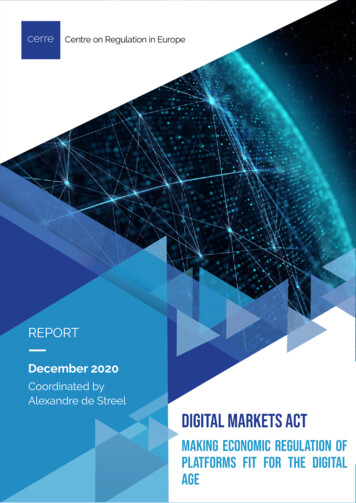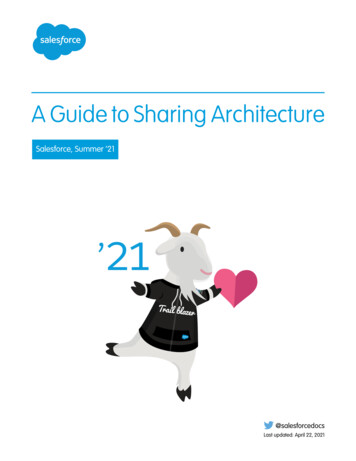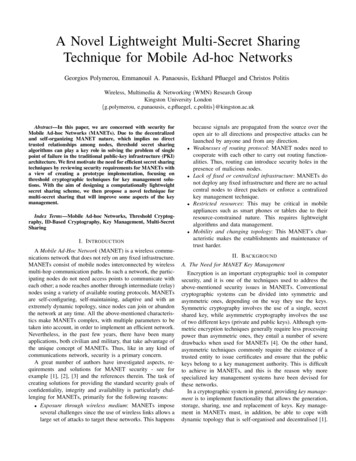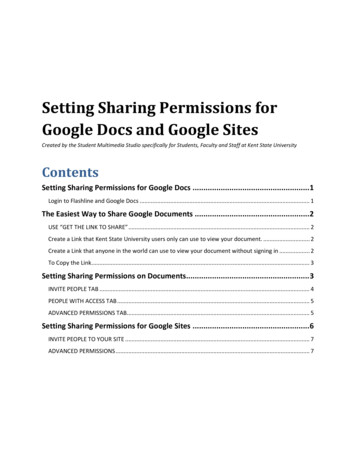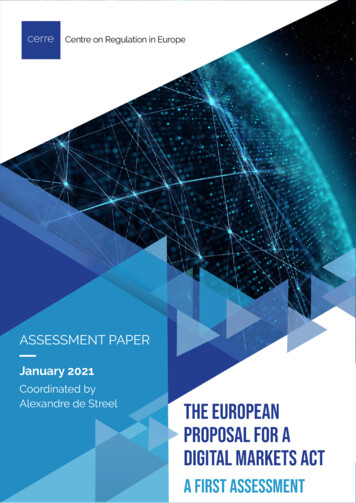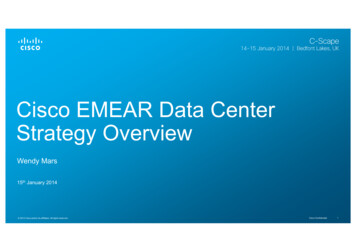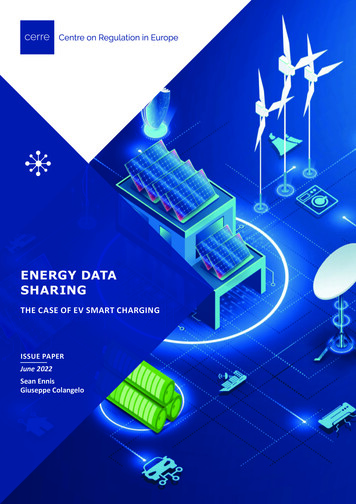
Transcription
ENERGY DATASHARINGTHE CASE OF EV SMART CHARGINGISSUE PAPERJune 2022Sean EnnisGiuseppe Colangelo
Energy Data Sharing: The Case of EV Smart ChargingAs provided for in CERRE's bylaws and procedural rules from its “Transparency & IndependencePolicy”, all CERRE research projects and reports are completed in accordance with the strictestacademic independence.The project, within the framework of which this report has been prepared, received the supportand/or input of the following CERRE member organisa ons: EDF, Huawei, and Ofgem. However, theybear no responsibility for the contents of this report. The views expressed in this CERRE report areatributable only to the authors in a personal capacity and not to any ins tu on with which they areassociated. In addi on, they do not necessarily correspond either to those of CERRE, or of any sponsoror of members of CERRE. Copyright 2022, Centre on Regula on in Europe (CERRE)info@cerre.eu –www.cerre.eu1
Energy Data Sharing: The Case of EV Smart ChargingTABLE OF CONTENTSAbout CERRE . 3About the Authors . 41. Introduc on . 52. Energy Data Sharing: The Case of EV Smart Charging . 63. Smart charging and its data needs. 84. European data sharing regimes . 124.1 Energy-specific data sharing regimes .155. Regulatory challenges . 175.1 APIs, standardisa on, and interoperability 175.2 Data Protec on and Cybersecurity .202
Energy Data Sharing: The Case of EV Smart ChargingABOUT CERREProviding top quality studies and dissemina on ac vi es, the Centre on Regula on in Europe (CERRE)promotes robust and consistent regula on in Europe’s network and digital industries. CERRE’smembers are regulatory authori es and operators in those industries as well as universi es.CERRE’s added value is based on: its original, mul disciplinary and cross-sector approach; the widely acknowledged academic creden als and policy experience of its team and associatedstaff members; its scien fic independence and impar ality; the direct relevance and meliness of its contribu ons to the policy and regulatory developmentprocess applicable to network industries and the markets for their services.CERRE's ac vi es include contribu ons to the development of norms, standards and policyrecommenda ons related to the regula on of service providers, to the specifica on of market rulesand to improvements in the management of infrastructure in a changing poli cal, economic,technological and social environment. CERRE’s work also aims at clarifying the respec ve roles ofmarket operators, governments and regulatory authori es, as well as at strengthening the exper seof the later, since in many Member States, regulators are part of a rela vely recent profession.3
Energy Data Sharing: The Case of EV Smart ChargingABOUT THE AUTHORSSean Ennis is Director of the Centre for Compe on Policy and aProfessor of Compe on Policy at Norwich Business School, University ofEast Anglia. Previously, he was a Senior Economist in the Compe onDivision of the OECD. Prior to that, he has served as an Execu ve Directorof the Compe on Commission of Mauri us, as an Economist at theEuropean Commission’s DG Compe on and at the U.S. Department ofJus ce’s An trust Division. Over the years, Mr Ennis has publishedresearch studies and reports published by economic journals andsubmited to the European Parliament, the G20, the OECD and the WorldBank. He has co-authored reports for regulatory and governmentagencies in Australia, Greece, Mexico, Romania, the United Kingdom andthe United States.Giuseppe Colangelo is a Jean Monnet Professor of European Innova onPolicy and an Associate Professor of Law and Economics at the Universityof Basilicata (Italy). He also serves as an Adjunct Professor of Markets,Regula on and Law, and Compe on and Markets of Innova on at LUISS(Italy). He is a fellow of the Stanford Law School and University of ViennaTransatlan c Technology Law Forum (TTLF), the scien fic coordinator ofthe Research Network for Digital Ecosystem, Economic Policy andInnova on (Deep-In), and an academic affiliate with the Interna onalCenter for Law & Economics (ICLE). His primary research interests arerelated to innova on policy, intellectual property, compe on policy,market regula on, and economic analysis of law.4
Energy Data Sharing: The Case of EV Smart Charging1. INTRODUCTIONThe green and digital transi ons are concomitantly underway. There is poten al for them to yieldsynergies with each other, as Europe moves towards a smart, integrated and cleaner energy system.Such a revised system could be based on variable and more distributed genera on and greaterelectrifica on. Digital technology can provide system op misa on and substan alopera onal/network infrastructure efficiency, support energy system integra on, and help op misingthe use of the exis ng grid capacity.Electricity networks already include substan al dynamic upda ng and data movement for the purposeof engaging in transac onal decisions over energy produc on, supply and, some mes, usage. But thesmall customer retail interface has remained rela vely passive, as has the retail customer usageresponsiveness to price, even with the introduc on of small-scale “distributed” genera on (such ashome-based photovoltaic (PV) cells) and “smart” meters that, in many implementa ons, have actuallybeen rela vely dumb 1.In its upcoming Ac on Plan on Digitalisa on of Energy, the European Commission aims to outline howEU policies and funding instruments can exploit the benefits of digital solu ons in the energy sectorwhile minimising their risks and environmental footprint 2. It will focus on five areas: Developing a European data-sharing infrastructure and a common European energy data space(compa ble with other data spaces) to foster the development of an interoperability framework.This is to create a compe ve market for energy services that supports planning and monitoringof energy infrastructure as well as demand-side flexibility;Empowering European ci zens with tools for par cipa on in energy markets as well as datadriven services and re/upskilling ini a ves. It will seek to learn and promote best prac ces fromresearch and innova on projects that developed new tools that make it easy for ci zens to grantaccess to their data and become ac ve players in the transi on;Driving the general uptake of digital tech in energy by fostering research, innova on andsuppor ng the scaling up of successful pilots (including for energy communi es);Improving the cybersecurity of the sector with a mix of legacy tech with smart tech, in alignmentwith the overarching cybersecurity framework, specifically the revised Direc ve on Security ofNetwork and Informa on Systems (NIS2) and the planned Network Code on cybersecurity ofcrossborder electricity flows (NCCS);Suppor ng the development and uptake of climate-neutral solu ons for ICT. This is tocomplement the European Digital Strategy 3 and promote coopera on between the energy anddigital sectors.1 The UK’s SMETS1 rollout could be cited as an example.2 European Commission, ‘Roadmap to the Ac on Plan on the Digitalisa on of the Energy Sector’, 2021.htps://ec.europa.eu/info/law/beter-regula on/have-your-say/ini a ves/13141-Digitalising-the-energy-sector-EU-ac on-plan en3 European Commission, ‘European Commission Digital Strategy’ C(2018) 7118 final, 21 November, 2018.5
Energy Data Sharing: The Case of EV Smart Charging2. ENERGY DATA SHARING: THE CASE OF EV SMARTCHARGINGThe European Commission aims to develop a digital-driven “European energy data space” to allow forand support data sharing and system integra on between the energy sector and other sectors, e.g.mobility. The sharing of such data, along with the general uptake of digital tools, will be cri cal inempowering EU ci zens and giving them a more ac ve role in the energy transi on and system.The Commission has recently unveiled the EU Data Act 4, which contains some high-level principles ondata sharing across sectors, supplemen ng the Data Governance Regula on 5. At the same me,stakeholders such as consumer organisa on BEUC 6, have been calling the Commission to go furtherand propose sector-specific rules for access to in-vehicle data. and the Commission is reportedlyplanning to propose such sector-specific legisla on in Q4 2022.With respect to data and energy, other EU legisla ve proposals will also have relevance, including theNetwork and Informa on Security Direc ve (NIS2) 7 and elements of the Fit for 55 package 8 such asthe Alterna ve Fuels Infrastructure Regula on (AFIR, repealing a previous Direc ve) 9, and the revisedEnergy Performance of Buildings Direc ve (EPBD) 10 and Renewable Energy Direc ve (REDII) 11.In this context, it is cri cal to iden fy the business case to encourage industry players and customersto share their data, as well as the key governance principles for the sharing of such data. Following abotom-up approach, industry players and na onal regulators have a key role to play in laying out thebases of this framework.CERRE is beginning its work at the intersec on of data and energy with a mapping focused on smartcharging points, whose successful rollout is cri cal for the EU’s energy transi on. They will not onlyhelp with the electrifica on of mobility but also with providing flexibility on when electricity isdemanded for charging, and based on vehicle bateries’ poten al to store energy at mes ofpar cularly high produc on and contribute back to the network at mes of scarcity.4 European Commission, ‘Proposal for a Regula on on harmonised rules on fair access to and use of data (Data Act)’, COM (2022) 68 final.5 Regula on (EU) 2022/868 on European data governance (Data Governance Act) [2022] OJ L 152/1.6 The acronym stands for Bureau Européen des Unions de Consommateurs.7 Proposal for a Direc ve on measures for a high common level of cybersecurity across the Union, repealing Direc ve (EU) 2016/1148,COM(2020) 823 final. In May 2022, the Council and the European Parliament reached an agreement on the final version of the Direc du-conseil-et-du-parlement-europeen/?utm source dsmsauto&utm medium email&utm campaign Strengthening EUwide cybersecurity and resilience %u2013 provisional agreement by the Council and the European Parliament).8 European Commission, ‘European Green Deal: Commission proposes transforma on of EU economy and society to meet climateambi ons’, (2021) en/IP 21 35419 Proposal for a Regula on on the deployment of alterna ve fuels infrastructure, and repealing Direc ve 2014/94/EU, COM(2021) 559final.10 Proposal for a Direc ve on the energy performance of buildings (recast), COM(2021) 802 final.11 Proposal for a Direc ve amending Direc ve (EU) 2018/2001, Regula on (EU) 2018/1999 and Direc ve 98/70/EC as regards thepromo on of energy from renewable sources, and repealing Council Direc ve (EU) 2015/652, COM(2021) 557 final.6
Energy Data Sharing: The Case of EV Smart ChargingThe European Commission is currently sugges ng a number of regulatory op ons to support therollout of charging points, but the data sharing aspect of the issue remains largely unaddressed andunexplored.In this context, CERRE has started a research ini a ve which will present guiding principles andrecommenda ons to the European Commission and other relevant stakeholders related to energydata sharing and smart charging. CERRE’s contribu on aims to feed into the discussions linked to theAc on Plan on Digitalisa on of Energy and sectoral ini a ves following on from the Data GovernanceRegula on and the Data Act.Key research ques ons to be addressed are: What property rights are included within the smart charging data?What is the business case for industry players and customers to share their data?What should be the overarching principles governing a European energy data space?What government interven ons or data standards are required to make specific use casessuccessful for achieving green transi on goals?By the end of the project, considering exis ng literature, interac ons with stakeholders and crosssectoral input, an assessment will be made and policy recommenda ons will be drawn and shared ina CERRE report.7
Energy Data Sharing: The Case of EV Smart Charging3. SMART CHARGING AND ITS DATA NEEDSAs the rollout of charging infrastructure for batery-powered vehicles expands, with an expected rapidincrease in this rollout in the years ahead to meet the ambi ous transport energy rebalancingpromised by 2035 in Europe, the possibility arises of adding unidirec onal and bidirec onal smartcharging 12. These expansion possibili es are not simply theore cal, as, in 2021, 17% of car sales wereelectric vehicles (EVs). A number of demonstra on projects have been undertaken. In unidirec onalsmart charging, the EV extracts electricity from the network at rates and mes that are coordinatedvia the use of digital planning in “communica on” between the batery charger and energy providers.This data-governed transac on would include informa on on the batery (including state of charge,power setpoint and capacity), the user needs (including priority of charging compared to ability towait, pricing for different mes of download and poten ally dynamic batery charging depending onexact network balancing needs and prices as they evolve over me), charging loca on and coststructure of the charging point. If 50 million EVs are on the road within a decade, that could represent3,500 GWh of storage capacity 13. This is between 2 to 3 mes the size of all the hydraulic storagecapaci es in Europe 14.Given that typical vehicles are parked 95% of the me, bidirec onal smart charging would add animportant further element to the system, by allowing the batery to feed energy into the system as adistributed producer. That is, a batery can be treated as a source of energy to the system, even ifmuch lower in output than an electricity plant. Regulators are increasingly recognising the value ofbidirec onal charging for energy systems, with the French transmission system operator RTE havingcer fied bidirec onal charging as a mature technology that can be used on the grid 15. Specifically, EVbateries can play into the electricity network as devices that are able to charge at mes of high supplycapacity and low-cost produc on, including when renewable energy sources (RES) would otherwisebe curtailed due to lack of demand, and then cease their charging to meet system balancing needsand ul mately also to contribute energy to the network at mes of produc on scarcity and high priceproduc on. EV bateries can perform arbitrage, and yield their owners, operators or intermediariesan arbitrage profit that could help to lower the effec ve cost of car bateries 16.See European Commission, ‘Best prac ces and assessment of regulatory measures for cost-efficient integra on of electric vehicles intothe electricity grid’, (2022) htps://op.europa.eu/en/publica on-detail/-/publica 13See Jean-Philippe Laurent, ‘Towards the mass adop on of smart and bidirec onal charging, the key contribu on of the “Fit for 55”package’, (2022) Eurac v, htps://www.eurac v.com/sec on/transport/opinion/towards-the-mass-adop on-of-smart-and-bidirec onalcharging-the-key-contribu on-of-the-fit-for-55-package/14 Hydraulic storage is currently the only compe ve way to “store” electricity and, like bateries, can be turned on instantly, whether forstorage or genera on (see Laurent, supra note 13).15 P vehicules%20electriques RTE Dreev V2G.pdf16See Stephan Meisel and Tanja Merfeld, ‘Economic incen ves for the adop on of electric vehicles: A classifica on and review of evehicle services’, 65 Transporta on Research Part D 264 (2018), for characterisa on of different economic uses of demand supply fromEV bateries which can also serve as one of the considera ons in lowering the cost of vehicles and increasing their rollout.128
Energy Data Sharing: The Case of EV Smart ChargingThe introduc on of unidirec onal and bidirec onal smart charging can deliver more efficiency. It mayalso require infrastructure system upgrades at the point of charging as well as, poten ally, beyond thecharging sta on to handle increased local variability in demand and supply, though this may vary bycountry 17. These costs are not taken directly into account in the costs of charging sta ons but willneed to be borne and shared out across system users 18. Part of the communica on cost ofbidirec onal smart charging may be borne outside the direct rela onship between the electricitysupplier, electricity buyer and batery “manager”. The willingness to enter into contracts and managethe rela onship will influence the types of contracts that are possible 19.Transac ons involving either unidirec onal or bi-direc onal smart charging can poten ally result indifferent “sellers” of electricity opera ng over the same infrastructure, along with different “buyers”while such a distributed development would create system management challenges when totalvolumes become large rela ve to the local load. With respect to charging EVs, the buyers can be bothcar bateries or aggregators who buy from car bateries (or who reduce their consump on on demandof system operators). At different mes of day, the buyers could become sellers. One can imagine thatapps over smartphones or car-based wireless would generate the orders to the system for smartbidirec onal charging, depending on system condi ons and prices for various aspects of the system,including the charging sta on. This requires secure communica ons to cars from distant controllers,and secure connec ons between charging sta ons and vehicles for the movement and monitoring ofelectricity “download” and “upload”.The par es involved in transac ons can poten ally include electricity distributors, electricity retailers,car users, car owners (in case of rental cars), car manufacturers, batery manufacturers, baterycharging sta on owners from both the private and public sphere, telecom networks, data networkson top of wireless or wireline networks, app owners and others. This list illustrates the variety ofpoten al market par cipants. The types of contracts that will eventually evolve in the market willlikely depend on who is best placed to supply electricity, buy electricity and arbitrage electricity. Theextent of data sharing and interoperability of data networks with each other is likely to impact theul mate efficiency of the system20.The economic use case for bateries could depend further on the number of op mum charging cyclesfor bateries, which typically have a limited number of cycles of recharging before they must beWhile some infrastructure improvement is required under the Energy Performance of Buildings Direc ve, it contains no smart chargingrequirement. See Andrea Mangipinto, Francesco Lombardi, Francesco Davide Sanvito, Ma ja Pavičević, Sylvain Quoilin, and EmanuelaColombo, ‘Impact of mass-scale deployment of electric vehicles and benefits of smart charging across all European countries’, 312Applied Energy 118676 (2022). The French RTE, the NSO, and Enedys, the DSO, for example, have determined that France’s network willremain stable even with large scale smart charging.18ENTSOE, ‘Electric Vehicle Integra on into Power Grid’ (2021) ntegra on-intopower-grids19See Bing Haung, Aart Gerard Meijssen, Jan Anne Annema, and Zofia Lukszo, ‘Are electric vehicle drivers willing to par cipate in vehicleto-grid contracts? A context-dependent stated choice experiment’, 156 Energy Policy 112410 (2021).20For a discussion of ini al points on how smart charging factors may integrate with data concerns, see EV Energy Taskforce, ‘DataAccessibility and Privacy’, (2021) king-group-4/; Id., ‘Engaging EV Users in SmartCharging and Energy Services’, (2021) king-group-2/; Id., ‘Cyber Security andSmart Charging’, (2021) king-group-3/; and Id., ‘Accessible Data for DecisionMaking’, (2020) four/.179
Energy Data Sharing: The Case of EV Smart Chargingreplaced. With current batery installa ons, the batery life will typically be longer than the transportuse case for the bateries, so that many cycles can be given over to smart charging without sacrificingthe core transport value of the batery. If the number of charging cycles designed into bateries fallssubstan ally in the future, given the large cost of new bateries, increasing the number of cycles usedfor delivering energy into the network would require that the margin from charging at low-costmoments and providing energy to the network at high-cost moments must, for the batery operator,exceed any efficiency loss from storage and any reduced effec ve batery life me from each cycle ofcharging and emptying of a batery. This point is more related to future designs than current onesthat, with a life me of 1000 cycles, are unlikely to decrease their transport effec ve life as a result ofthe use of bi-direc onal smart charging.Yet lack of interoperability, from differing standards, limits user choice about where to charge andhow to pay and prevents users from benefi ng from the diversity of smart charging services availablein the market. If car charging sta ons are, like petrol sta ons, the unique deciders of the charging thathappens over their infrastructure, this will create a limited regime for charging while ensuring highincen ves for construc on and may create localised market power that results in less return on theEV investment. On the other hand, if car charging sta ons are organised more like ATMs, with mul plesuppliers and user combina ons able to access the infrastructure, poten ally at a price, the profitsfrom construc ng the charging sta ons might be lower, so investment incen ves would be lower, butopportuni es for arbitrage by batery owners might be increased, and give them more incen ves toinvest in EV. A widescale charging network in Europe will have chargers at homes, on-street parking,at workplaces and along roads.Given the complex and varied interests of involved par es, the models that govern the system willlikely differ from one country to another and evolve over me in varied responses to reflect differingincen ves of different players. Flexibility in ul mate modes of opera on is thus crucial to build intothe system during its early growth. Criteria for successful use of informa on will include ensuring that: Informa on provided in one format can be read by all other users eligible to access the data;Energy sources that are viable are given an incen ve to produce as long as storage is expected tobe profitable;Profitable storage is incen vised to occur including for bateries to be purchased;Batery charging sta ons earn a sufficient return to also be incen vised to build out in line withexpected future demand; andEnergy from a batery can poten ally be used at home, used in a building or used in the grid.The opportunity of rolling out smart charging is high. Grid stability seems high in many countries andresistant to large-scale batery charging, with the me variable part of smart charging being quite10
Energy Data Sharing: The Case of EV Smart Chargingimportant to guarantee this result across countries 21. To provide the right incen ves for rollout,innova on at the grid level, charging sta on level, batery level and customer level must all interactto complement each other and align interests, otherwise, socially desirable innova ons will not bemade 22. Nonetheless, conflicts of interest will remain with different types of en ty seeking to maintainsuitable return on investment along with access to the new profit streams.21 One study suggests that uncontrolled charging by a fleet of EV cars that is of substan al size (e.g., 50% of the fleet) could lead to gridinstability and voltage varia on. See H. Li and X. Bai, ‘Impacts of electric vehicle charging on the electricity grid’, (2011)htps://www.researchgate.net/publica on/297055070 Impacts of electric vehicles charging on distribu on grid22 See Ernst & Young and Eurelectric, ‘Power sector accelera ng e-mobility: Can u li es turn EVs into a grid asset?’, (2021)htps://www.eurelectric.org/media/5704/power sector accelera ng e-mobility-2022 eyeurelectric report-2022-030-0059-01-e.pdf;and David Deller, Thanh Doan, and Franco Mariuzzo with Sean Ennis, Amelia Fletcher and Peter Ormosi, ‘Compe on and innova on indigital markets’, BEIS Working Paper No. 40 ernment/uploads/system/uploads/atachment data/file/1003985/uae-ccp-report 1 .pdf11
Energy Data Sharing: The Case of EV Smart Charging4. EUROPEAN DATA SHARING REGIMESIn the last years, on the premise that the value of data lies in its use and re-use, access to data andrelated data sharing prac ces have gained prominent aten on among policy makers as a crucialfactor in unlocking compe on and enabling innova on to flourish. The European Union has been aforerunner in promo ng the free flows of data with a broad array of heterogeneous legisla veini a ves, many of them designed to empower digital consumers and making them consciousdecision-makers in digital markets 23.Notably, the General Data Protec on Regula on (GDPR) enshrined a general data portability right forindividuals 24; the Second Payment Service Direc ve (PSD2) introduced a rule on sector-specific accessto account data 25; the Regula on on the free-flow of non-personal data encouraged thedevelopment of self-regulatory codes of conduct to facilitate data sharing prac ces in business-tobusiness rela onships 26; the Open Data Direc ve aimed at promo ng business-to-government datasharing collabora on suppor ng the wide availability and re-use of public sector informa on forprivate or commercial purposes 27; and the Data Governance Act pointed to increase trust in sharingdata, lower transac on costs linked to business-to-business and consumer-to-business data sharing,and harmonise condi ons for the use of certain public sector data 28. Moreover, the strategic roleplayed by large pla orm-based digital ecosystems and the growing relevance of the Internet of Things(IoT) prompted the European ins tu ons to introduce interoperability obliga ons in the recentlyadopted Digital Markets Act (DMA) 29 and in the proposal for a Data Act 30.These data-related legisla ve ini a ves significantly differ among themselves in terms of scope andapproach. Some interven ons are horizontal (i.e., cross-sector), others are sector-specific; somemandate data sharing, others envisage measures to facilitate voluntary sharing; some introducegeneral data rights, and others allow asymmetric data access rights. However, they share one essen alGiuseppe Colangelo and Mariateresa Maggiolino, ‘From fragile to smart consumers: shi ing paradigm for the digital era’, 35 ComputerLaw & Security Review 173 (2019). For an overview of the European ini a ves, see European Commission, Commission Staff WorkingDocument on ‘Common European Data Spaces’, SWD(2022) 45 final.24Regula on (EU) 2016/679 of the European Parliament and of the Council of 27 April 2016 on the protec on of natural persons withregard to the processing of personal data and on the free movement of such data, and repealing Direc ve 95/46/EC [2016] OJ L 119/1,Ar cle 20.25Direc ve (EU) 2015/2366 of the European Parliament and of the Council of 25 November 2015 on payment services in the internalmarket, amending Direc ves 2002/65/EC, 2009/110/EC and 2013/36/EU and Regula on (EU) No 1093/2010, and repealing Direc ve2007/64/EC, [2015] OJ L 337/35, Ar cle 67.26Regula on (EU) 2018/1807 of the European Parliament and of the Council of 14 November 2018 on a framework for the free flow ofnon-personal data in the European Union, [2018] OJ L 303/59.27Direc ve (EU) 2019/1024 of the European Parliament and of the Council of 20 June 2019 on open data and the re-use of public sectorinforma on, [2019] OJ L 172/56.28Data Governance Act, supra note 5.23Regula on (EU) on contestable and fair markets in the digital sector (Digital Markets Act). The text approved by the PermanentRepresenta ves Commitee (Coreper) is available at -xx22.pdf30Data Act, supra note 4. See Oscar Borgogno and Giuseppe Colangelo, ‘Shaping interoperability for the IoT: the case for ecosystemtailored standardisa on’, (2022) Deep-In Working Paper, htps://papers.ssrn.com/sol3/papers.cfm?abstract id 41068942912
Energy Data Sharing: The Case of EV Smart Chargingtechnical feature, namely the strong reliance on Applica on Programming Interfaces (APIs) as a keyenabler to ensure a sound and effec ve data-sharing ecosystem 31.Moreover, with regard to the sharing regime, we are witnessing a progressive shi towardsinteroperability. In the European data strategy, to overcome legal and
5 Regula on (EU) 2022/868 on European data governance (Data Governance Act) [2022] OJ L 152/1. 6 The acronym stands for Bureau Européen des Unions de Consommateurs. 7 Proposal for a Direc ve on measures for a high common level of cybersecurity across the Union, repealing Direc ve (EU) 2016/1148, COM(2020) 823 final.
